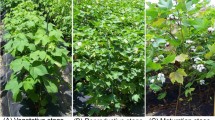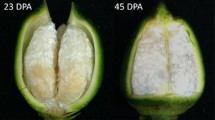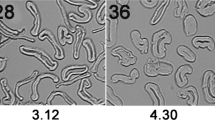Abstract
The amount of secondary cell wall (SCW) cellulose in the fiber affects the quality and commercial value of cotton. Accurate assessments of SCW cellulose are essential for improving cotton fibers. Fourier transform infrared (FT-IR) spectroscopy enables distinguishing SCW from other cell wall components in a rapid and non-invasive way. Thus it has been used for monitoring SCW development in model plants. Recently, several FT-IR methods have been proposed for monitoring cotton fiber development. However, they are rarely utilized for assessing SCW cellulose from cotton fiber due to limited validation with various cotton species grown in different conditions. Thus, we compared and validated three FT-IR methods including two previously proposed methods analyzing entire spectra or specific bands as well as a new method analyzing FT-IR spectral regions corresponding to cellulose with various cotton fibers grown in planta and in vitro. Comparisons of the FT-IR methods with reference methods showed that the two FT-IR methods analyzing the entire spectra or cellulose regions by principal component analysis monitored SCW qualitatively, whereas the FT-IR method analyzing specific bands (708, 730, and 800 cm−1) by a simple algorithm allowed the monitoring of SCW cellulose levels quantitatively. The quantitative FT-IR method is a potential substitute for lengthy and laborious chemical assays for monitoring SCW cellulose levels from cotton fibers, and it can be used for a better understanding of cotton fiber SCW development and as a part of the quality assessment tools used to guide choices for improving fiber quality.









Similar content being viewed by others
References
Abidi N, Manike M (2017) X-ray diffraction and FTIR investigations of cellulose deposition during cotton fiber development. Text Res J 0040517516688634
Abidi N, Hequet E, Cabrales L, Gannaway J, Wilkins T, Wells LW (2008) Evaluating cell wall structure and composition of developing cotton fibers using Fourier transform infrared spectroscopy and thermogravimetric analysis. J Appl Polym Sci 107:476–486
Abidi N, Cabrales L, Hequet E (2010a) Fourier transform infrared spectroscopic approach to the study of the secondary cell wall development in cotton fiber. Cellulose 17:309–320
Abidi N, Hequet E, Cabrales L (2010b) Changes in sugar composition and cellulose content during the secondary cell wall biogenesis in cotton fibers. Cellulose 17:153–160
Abidi N, Cabrales L, Haigler CH (2014) Changes in the cell wall and cellulose content of developing cotton fibers investigated by FTIR spectroscopy. Carbohydr Polym 100:9–16
Åkerholm M, Hinterstoisser B, Salmén L (2004) Characterization of the crystalline structure of cellulose using static and dynamic FT-IR spectroscopy. Carbohydr Res 339:569–578
Applequist WL, Cronn R, Wendel JF (2001) Comparative development of fiber in wild and cultivated cotton. Evol Dev 3:3–17
Beasley C, Ting IP (1974) Effects of plant growth substances on in vitro fiber development from unfertilized cotton ovules. Am J Bot 61:188–194
Brims M, Hwang H (2010) Introducing Cottonscope: a rapid and precise measurement of cotton fibre maturity based on siromat. National Cotton Council, New Orleans
Brown DM (2005) Identification of novel genes in Arabidopsis involved in secondary cell wall formation using expression profiling and reverse genetics. Plant Cell 17:2281–2295. https://doi.org/10.1105/tpc.105.031542
Chen L, Carpita NC, Reiter WD, Wilson RH, Jeffries C, McCann MC (1998) A rapid method to screen for cell-wall mutants using discriminant analysis of Fourier transform infrared spectra. Plant J 16:385–392
Driemeier C, Calligaris GA (2011) Theoretical and experimental developments for accurate determination of crystallinity of cellulose I materials. J Appl Crystallogr 44:184–192
Fang L, Tian R, Li X, Chen J, Wang S, Wang P, Zhang T (2014) Cotton fiber elongation network revealed by expression profiling of longer fiber lines introgressed with different Gossypium barbadense chromosome segments. BMC Genomics 15:838
French AD, Santiago Cintrón M (2013) Cellulose polymorphy, crystallite size, and the Segal crystallinity index. Cellulose 20:583–588
Gordon S, Rodgers J (2017) Cotton fibre cross-section properties. In: Gordon S, Abidi N (eds) Cotton fibres, characteristics, uses and performance. Nova Science Publishers, Inc., New York, pp 65–86
Haigler C (2010) Physiological and anatomical factors determining fiber structure and utility. In: Stewart JM, Oosterhuis DM, Heitholt JJ, Mauney JR (eds) Physiology of cotton. Springer, New York, pp 33–47
Hsieh Y-L (1999) Structural development of cotton fibers and linkages to fiber quality. In: Basra AS (ed) Cotton fibers developmental biology, quality improvement, and textile processing. Haworth Press, Inc., New York, pp 137–165
Imai T, Sugiyama J (1998) Nanodomains of Iα and Iβ cellulose in algal microfibrils. Macromolecules 31:6275–6279
Kemsley EK (1998) Discriminant analysis and class modelling of spectroscopic data. Wiley, Chichester
Kim HJ (2015) Fiber biology. In: Fang DD, Percy RG (eds) Cotton, 2nd edn. Agronomy monograph. American Society of Agronomy, Crop Science Society of America, and Soil Science Society of America, Madison, WI, pp 97–127
Kim HJ, Triplett BA (2001) Cotton fiber growth in planta and in vitro. Models for plant cell elongation and cell wall biogenesis. Plant Physiol 127:1361–1366
Kim HJ, Triplett BA, Zhang H-B, Lee M-K, Hinchliffe DJ, Li P, Fang DD (2012) Cloning and characterization of homeologous cellulose synthase catalytic subunit 2 genes from allotetraploid cotton (Gossypium hirsutum L.). Gene 494:181–189
Kim HJ, Tang Y, Moon HS, Delhom CD, Fang DD (2013a) Functional analyses of cotton (Gossypium hirsutum L.) immature fiber (im) mutant infer that fiber cell wall development is associated with stress responses. BMC Genomics 14:889
Kim SH, Lee CM, Kafle K (2013b) Characterization of crystalline cellulose in biomass: basic principles, applications, and limitations of XRD, NMR, IR, Raman, and SFG. Korean J Chem Eng 30:2127–2141
Kim HJ, Rodgers J, Delhom C, Cui X (2014) Comparisons of methods measuring fiber maturity and fineness of Upland cotton fibers containing different degree of fiber cell wall development. Text Res J 84:1622–1633
Kim HJ et al (2017) Comparative physical and chemical analyses of cotton fibers from two near isogenic upland lines differing in fiber wall thickness. Cellulose 24:2385–2401
Kohel R, Richmond T, Lewis C (1970) Texas marker-1. Description of a genetic standard for Gossypium hirsutum L. Crop Sci 10:670–671
Langan P, Nishiyama Y, Chanzy H (2001) X-ray structure of mercerized cellulose II at 1 Å resolution. Biomacromolecules 2:410–416
Lee CM, Dazen K, Kafle K, Moore A, Johnson DK, Park S, Kim SH (2015a) Correlations of apparent cellulose crystallinity determined by XRD, NMR, IR, Raman, and SFG methods. In: Rojas OJ (ed) Cellulose chemistry and properties: fibers, nanocelluloses and advanced materials. Advances in polymer science. Springer, Cham, pp 115–131
Lee CM, Kafle K, Belias DW, Park YB, Glick RE, Haigler CH, Kim SH (2015b) Comprehensive analysis of cellulose content, crystallinity, and lateral packing in Gossypium hirsutum and Gossypium barbadense cotton fibers using sum frequency generation, infrared and Raman spectroscopy, and X-ray diffraction. Cellulose 22:971–989
Li F et al (2014) Genome sequence of the cultivated cotton Gossypium arboreum. Nat Genet 46:567–572
Li F et al (2015) Genome sequence of cultivated Upland cotton (Gossypium hirsutum TM-1) provides insights into genome evolution. Nat Biotechnol 33:524–530
Liu Y, Kim HJ (2015) Use of Attenuated Total Reflection Fourier Transform Infared (ATR FT-IR) spectroscopy in direct, non-destructive, and rapid assessment of developmental cotton fibers grown in planta and in culture. Appl Spectrosc 69:1004–1010
Liu Y, Thibodeaux D, Gamble G (2011) Development of Fourier transform infrared spectroscopy in direct, non-destructive, and rapid determination of cotton fiber maturity. Text Res J 81:1559–1567
Liu Y, Thibodeaux D, Gamble G, Bauer P, VanDerveer D (2012a) Comparative investigation of Fourier transform infrared (FT-IR) spectroscopy and X-ray diffraction (XRD) in the determination of cotton fiber crystallinity. Appl Spectrosc 66:983–986
Liu Y, Thibodeaux D, Gamble G, Bauer PJ, Van Derveer D (2012b) FT-MID-IR spectroscopic investigation of fiber maturity and crystallinity at single boll level and a comparison with XRD approach. In: Beltwide Cotton Conference, Orlando, FL. National Cotton Council, pp 1213–1222
Long RL, Bange MP, Gordon SG, Constable GA (2010) Measuring the maturity of developing cotton fibers using an automated polarized light microscopy technique. Text Res J 80:463–471
Lutterotti L (2010) Total pattern fitting for the combined size–strain–stress–texture determination in thin film diffraction. Nucl Instrum Methods Phys Res Sect B 268:334–340
McCann MC, Hammouri M, Wilson R, Belton P, Roberts K (1992) Fourier transform infrared microspectroscopy is a new way to look at plant cell walls. Plant Physiol 100:1940–1947
McCann MC et al (2001) Approaches to understanding the functional architecture of the plant cell wall. Phytochemistry 57:811–821
Meinert MC, Delmer DP (1977) Changes in biochemical composition of the cell wall of the cotton fiber during development. Plant Physiol 59:1088–1097
Mouille G, Robin S, Lecomte M, Pagant S, Höfte H (2003) Classification and identification of Arabidopsis cell wall mutants using Fourier-Transform InfraRed (FT-IR) microspectroscopy. Plant J 35:393–404
Nam S, French AD, Condon BD, Concha M (2016) Segal crystallinity index revisited by the simulation of X-ray diffraction patterns of cotton cellulose Iβ and cellulose II. Carbohydr Polym 135:1–9
Nelson ML, O’Connor RT (1964) Relation of certain infrared bands to cellulose crystallinity and crystal lattice type. Part II. A new infrared ratio for estimation of crystallinity in celluloses I and II. J Appl Polym Sci 8:1325–1341
Nishiyama Y, Langan P, Chanzy H (2002) Crystal structure and hydrogen-bonding system in cellulose Iβ from synchrotron X-ray and neutron fiber diffraction. J Am Chem Soc 124:9074–9082
O’Connor RT, DuPré EF, Mitcham D (1958) Applications of infrared absorption spectroscopy to investigations of cotton and modified cottons: part I: physical and crystalline modifications and oxidation. Text Res J 28:382–392
Oh SY et al (2005) Crystalline structure analysis of cellulose treated with sodium hydroxide and carbon dioxide by means of X-ray diffraction and FTIR spectroscopy. Carbohydr Res 340:2376–2391
Park S, Baker JO, Himmel ME, Parilla PA, Johnson DK (2010) Cellulose crystallinity index: measurement techniques and their impact on interpreting cellulase performance. Biotechnol Biofuels 3:1
Paudel D, Hequet E, Noureddine A (2013) Evaluation of cotton fiber maturity measurements. Ind Crops Prod 45:435–441
Rodgers J, Delhom C, Hinchliffe D, Kim HJ, Cui X (2013) A rapid measurement for cotton breeders of maturity and fineness from developing and mature fibers. Text Res J 83:1439–1451
Sassi J-F, Tekely P, Chanzy H (2000) Relative susceptibility of the Iα and Iβ phases of cellulose towards acetylation. Cellulose 7:119–132
Schultz T, McGinnis G, Bertran M (1985) Estimation of cellulose crystallinity using fourier transform-infrared spectroscopy and dynamic thermogravimetry. J Wood Chem Technol 5:543–557
Segal L, Creely J, Martin A Jr, Conrad C (1959) An empirical method for estimating the degree of crystallinity of native cellulose using the X-ray diffractometer. Text Res J 29:786–794
Singh B, Cheek HD, Haigler CH (2009) A synthetic auxin (NAA) suppresses secondary wall cellulose synthesis and enhances elongation in cultured cotton fiber. Plant Cell Rep 28:1023–1032. https://doi.org/10.1007/s00299-009-0714-2
Updegraff DM (1969) Semimicro determination of cellulose in biological materials. Anal Biochem 32:420–424
Vorwerk S, Somerville S, Somerville C (2004) The role of plant cell wall polysaccharide composition in disease resistance. Trends Plant Sci 9:203–209
Wakelyn PJ et al (2010) Cotton fiber chemistry and technology, vol 17. International fiber science and technology series. CRC Press, New York
Wang C, Lv Y, Xu W, Zhang T, Guo W (2014) Aberrant phenotype and transcriptome expression during fiber cell wall thickening caused by the mutation of the Im gene in immature fiber (im) mutant in Gossypium hirsutum L. BMC Genomics 15:94
Wendel JF, Cronn RC (2003) Polyploidy and the evolutionary history of cotton. Adv Agron 78:139–186
Yamamoto H, Horii F, Hirai A (1996) In situ crystallization of bacterial cellulose II. Influences of different polymeric additives on the formation of celluloses I α and I β at the early stage of incubation. Cellulose 3:229–242
Zhang T et al (2015) Sequencing of allotetraploid cotton (Gossypium hirsutum L. acc. TM-1) provides a resource for fiber improvement. Nat Biotechnol 33:531–537
Acknowledgments
This research was supported by the USDA-ARS Research Project #6054-21000-017-00D, and Cotton Incorporated-Sponsored Project #12-199. Authors thank Drs. Zhongqi He and Huai Cheng of USDA-ARS, Southern Regional Research Center for critically reviewing the manuscript. Authors acknowledge Ms. Tracy Condon for fiber sample preparation, and Mr. Wilson Buttram and Keith Stevenson for preparing cotton fields. Mention of trade names or commercial products in this article is solely for the purpose of providing specific information and does not imply recommendation or endorsement by the U.S. Department of Agriculture which is an equal opportunity provider and employer.
Author information
Authors and Affiliations
Corresponding author
Electronic supplementary material
Below is the link to the electronic supplementary material.
Rights and permissions
About this article
Cite this article
Kim, H.J., Liu, Y., French, A.D. et al. Comparison and validation of Fourier transform infrared spectroscopic methods for monitoring secondary cell wall cellulose from cotton fibers. Cellulose 25, 49–64 (2018). https://doi.org/10.1007/s10570-017-1547-8
Received:
Accepted:
Published:
Issue Date:
DOI: https://doi.org/10.1007/s10570-017-1547-8




